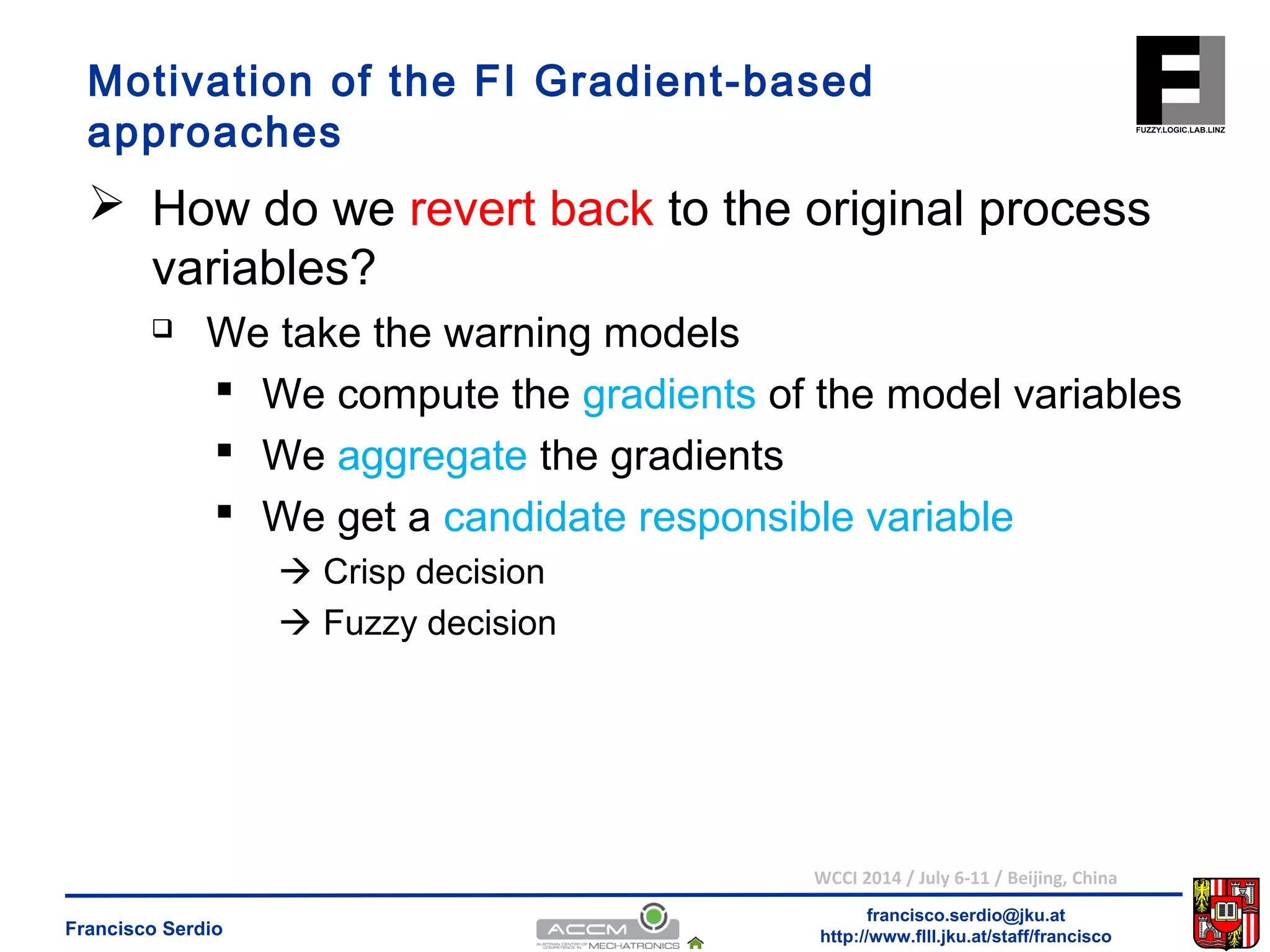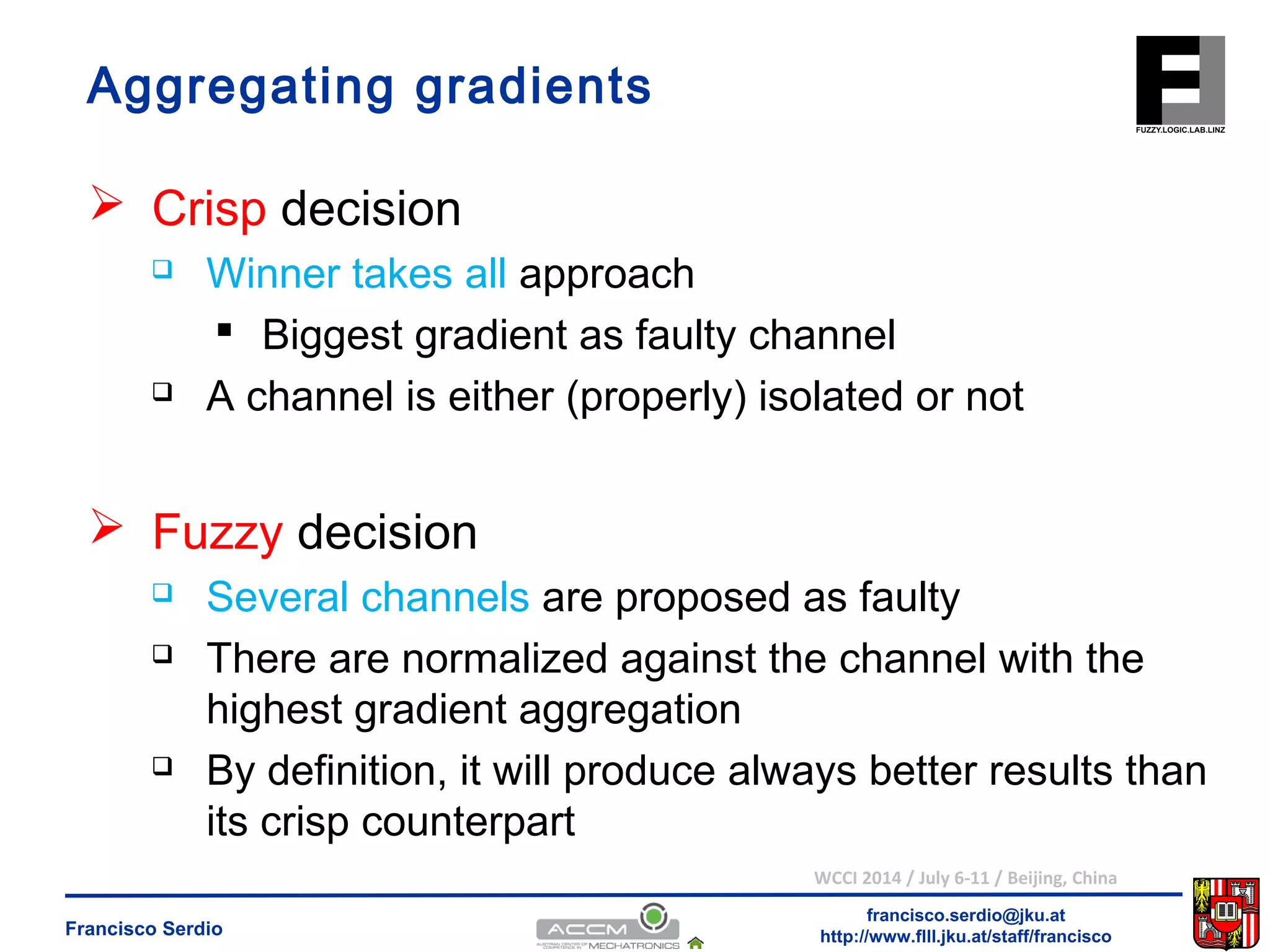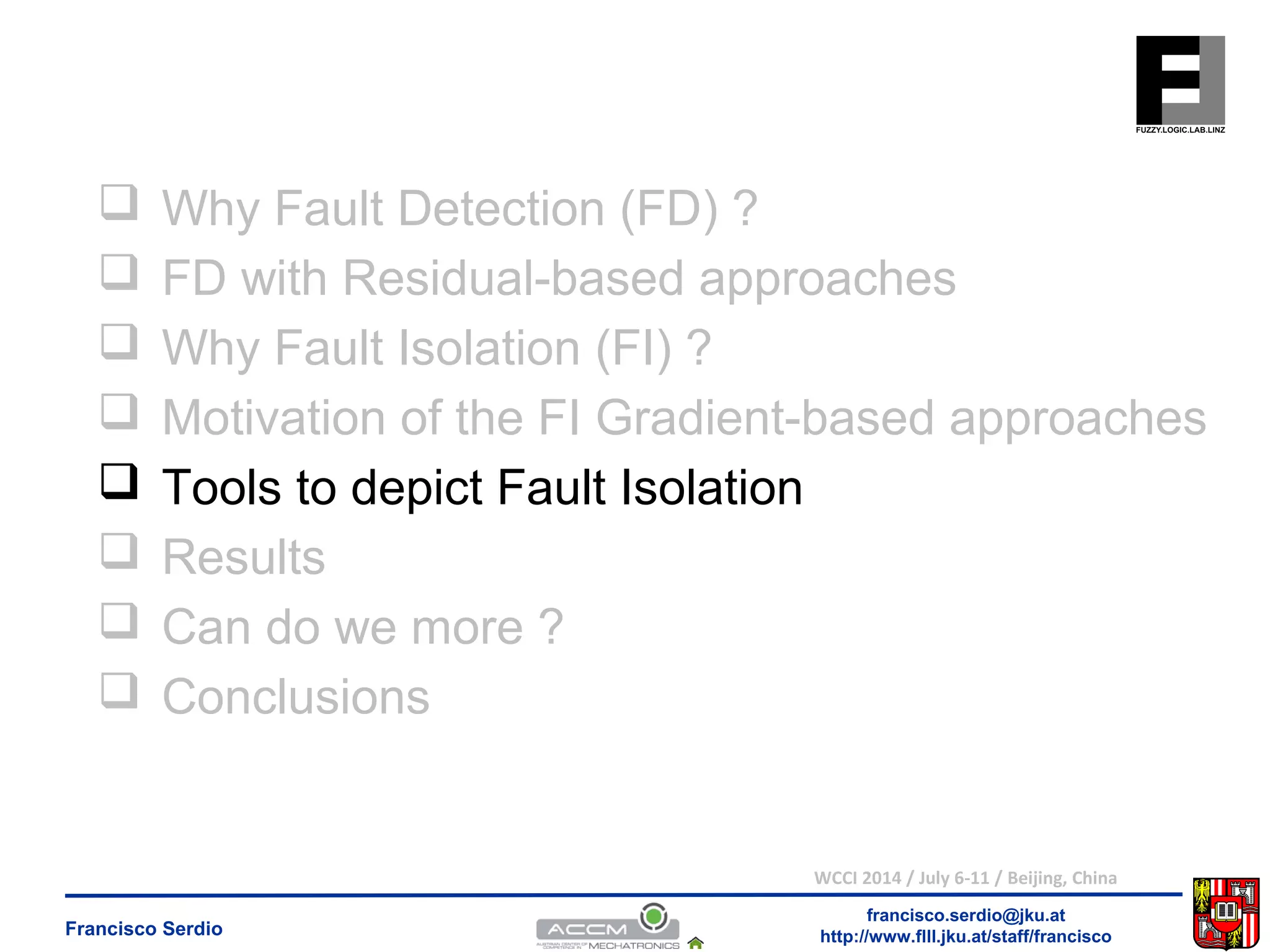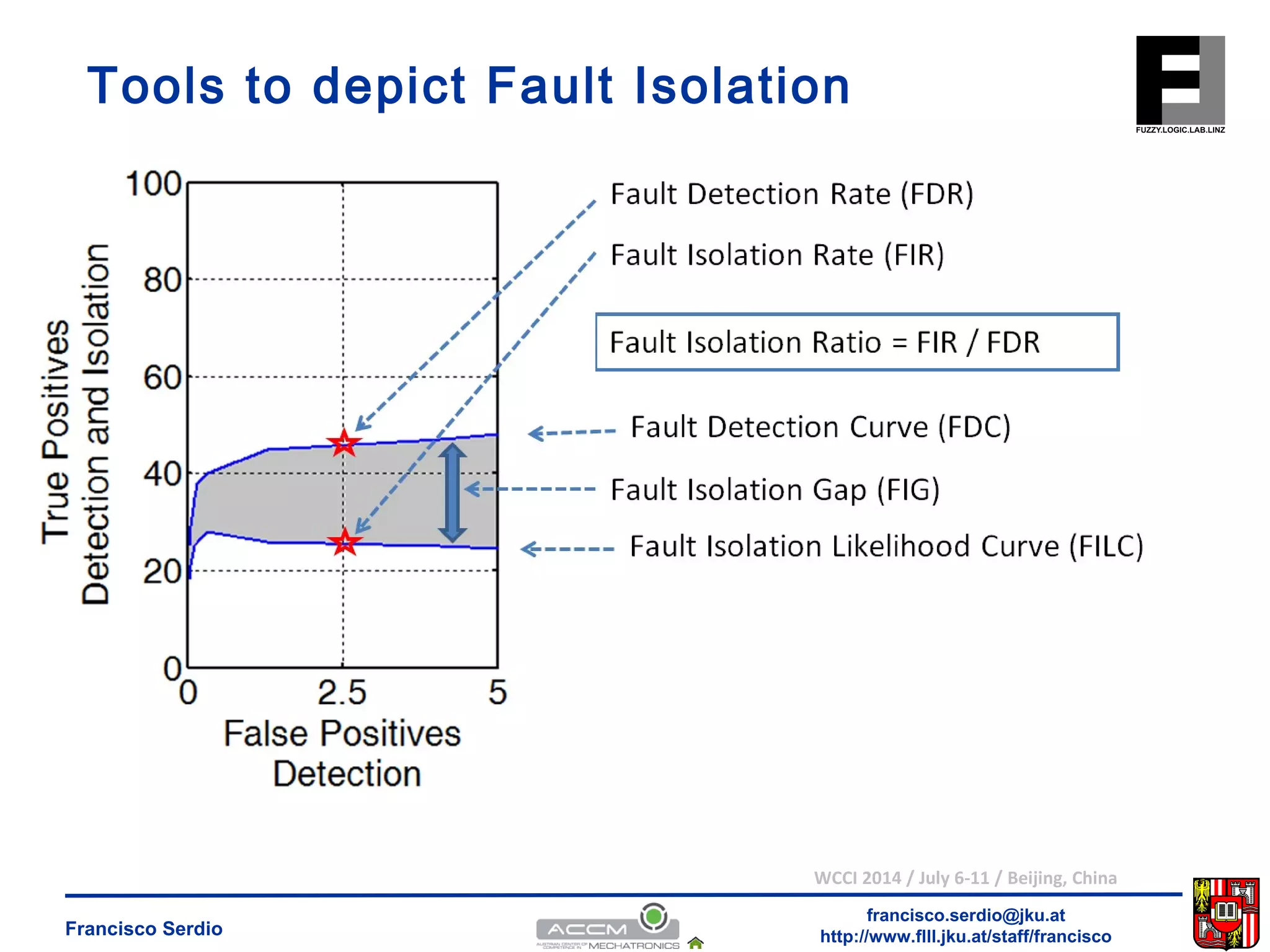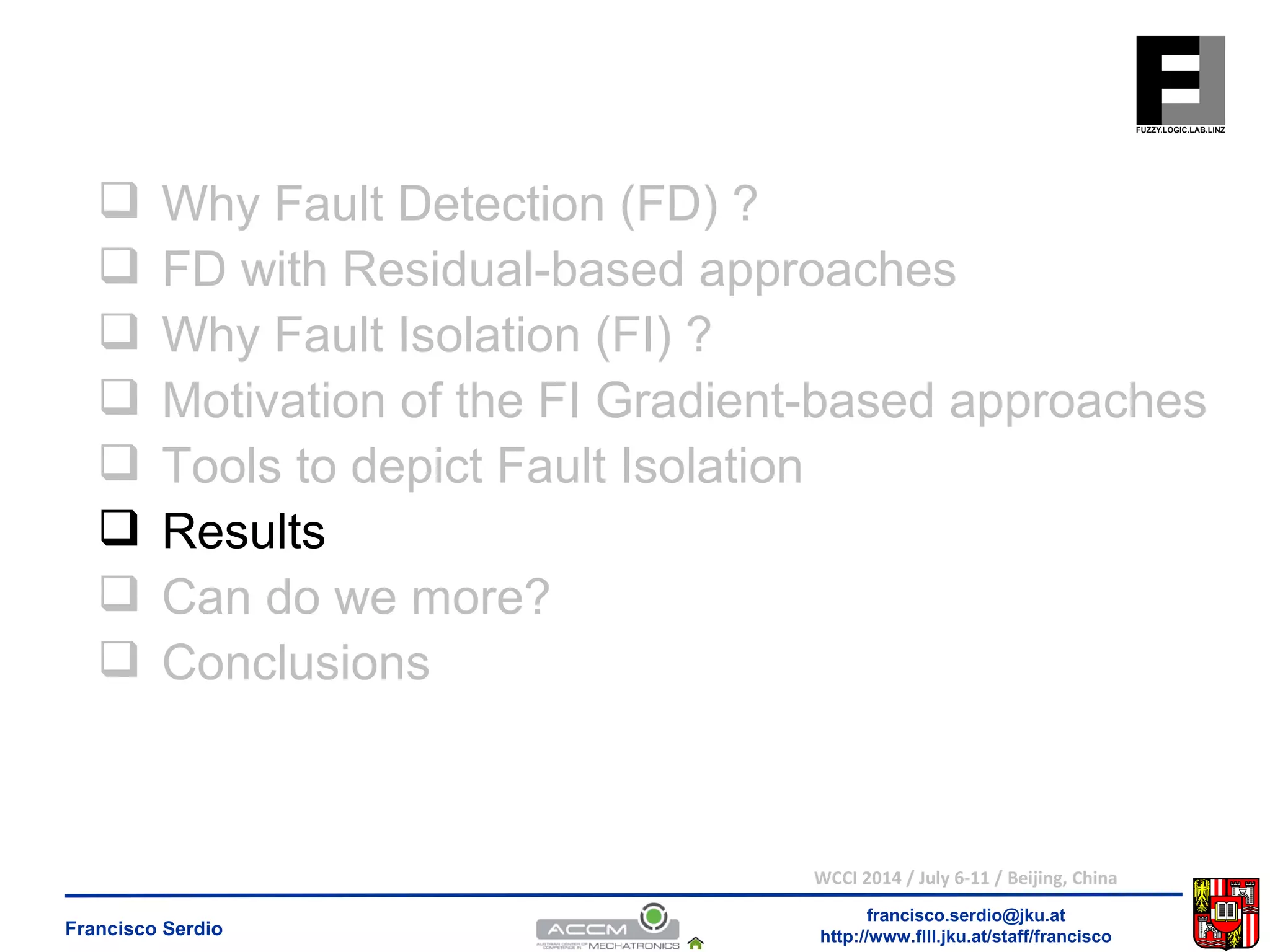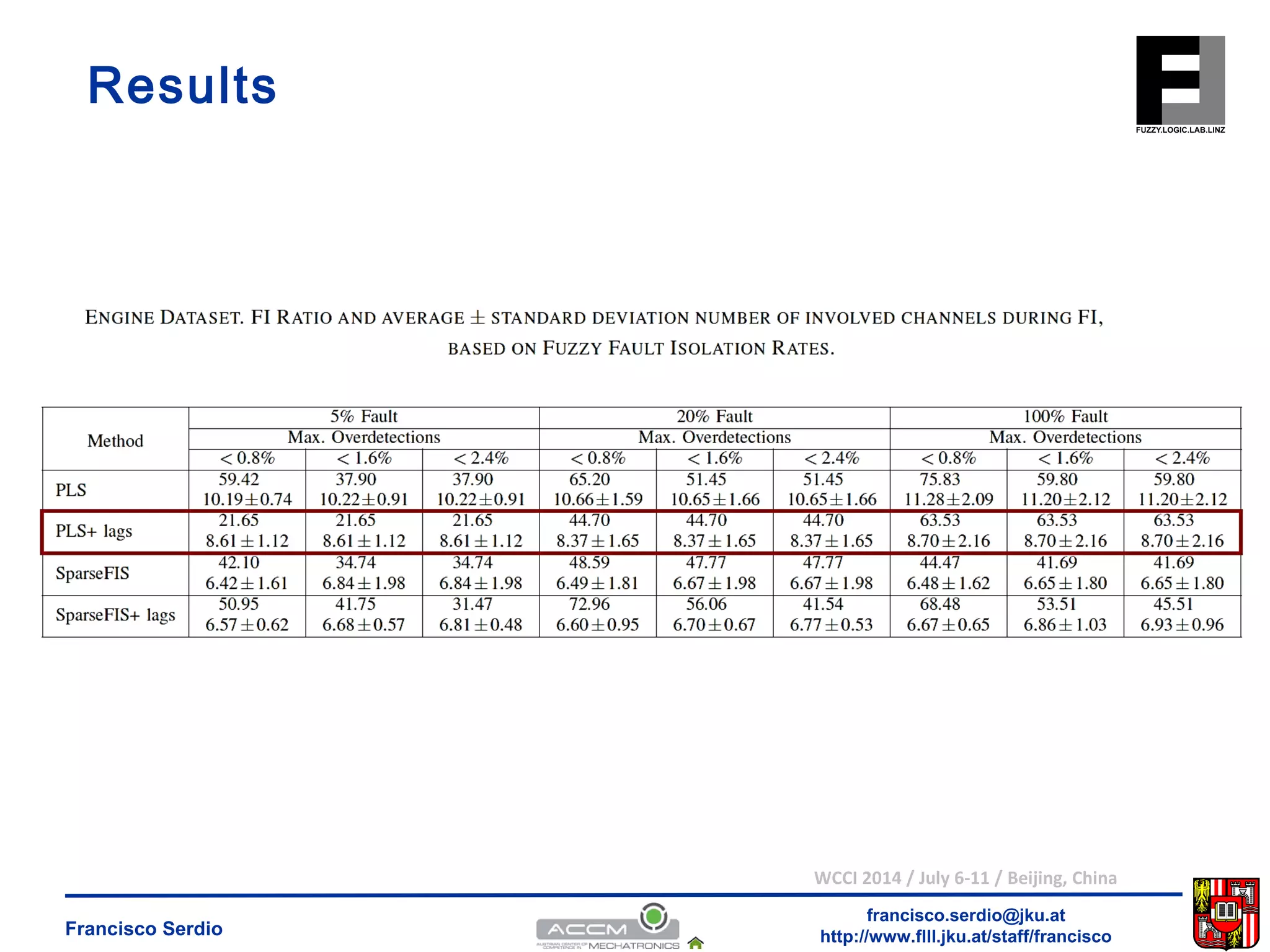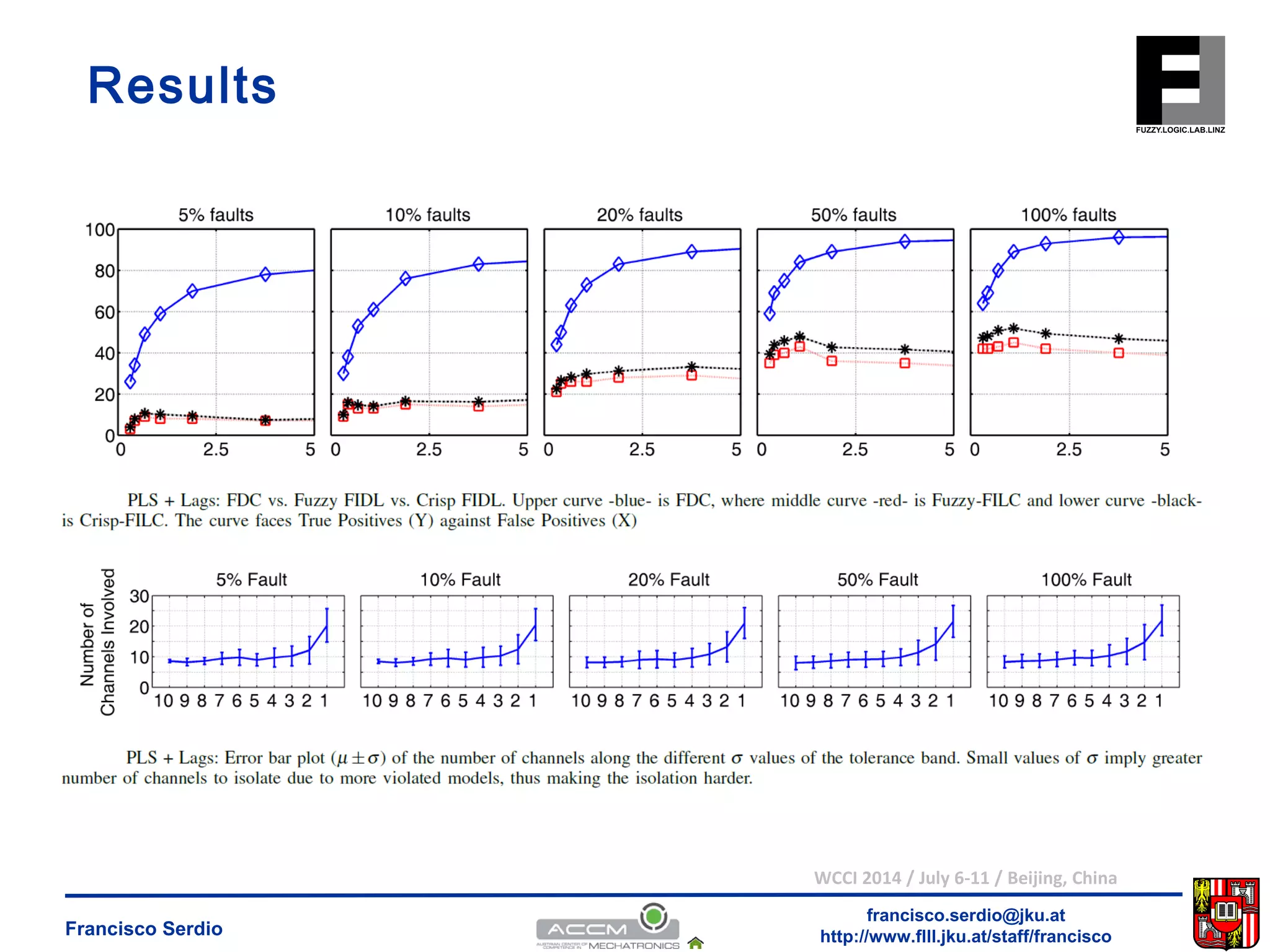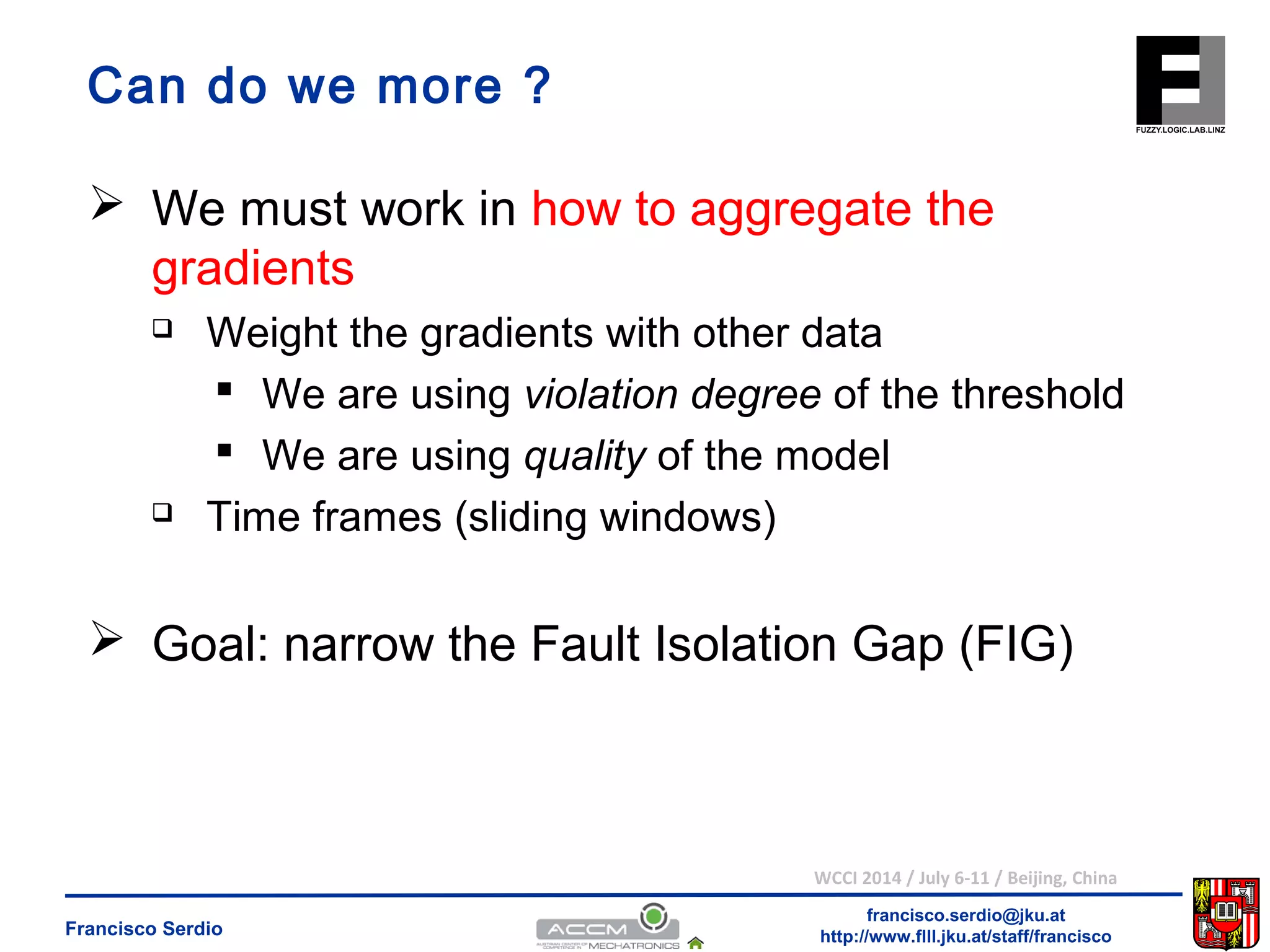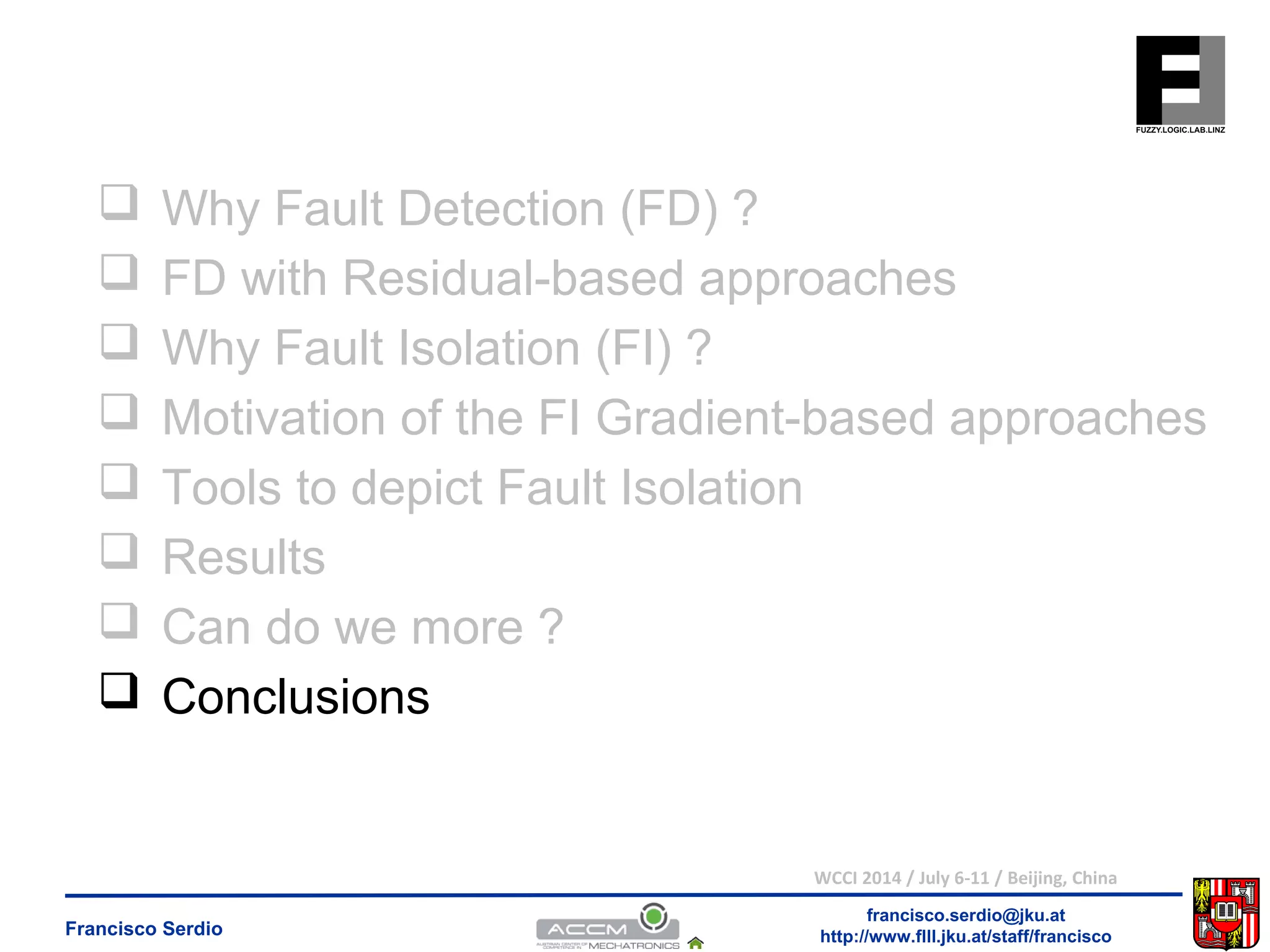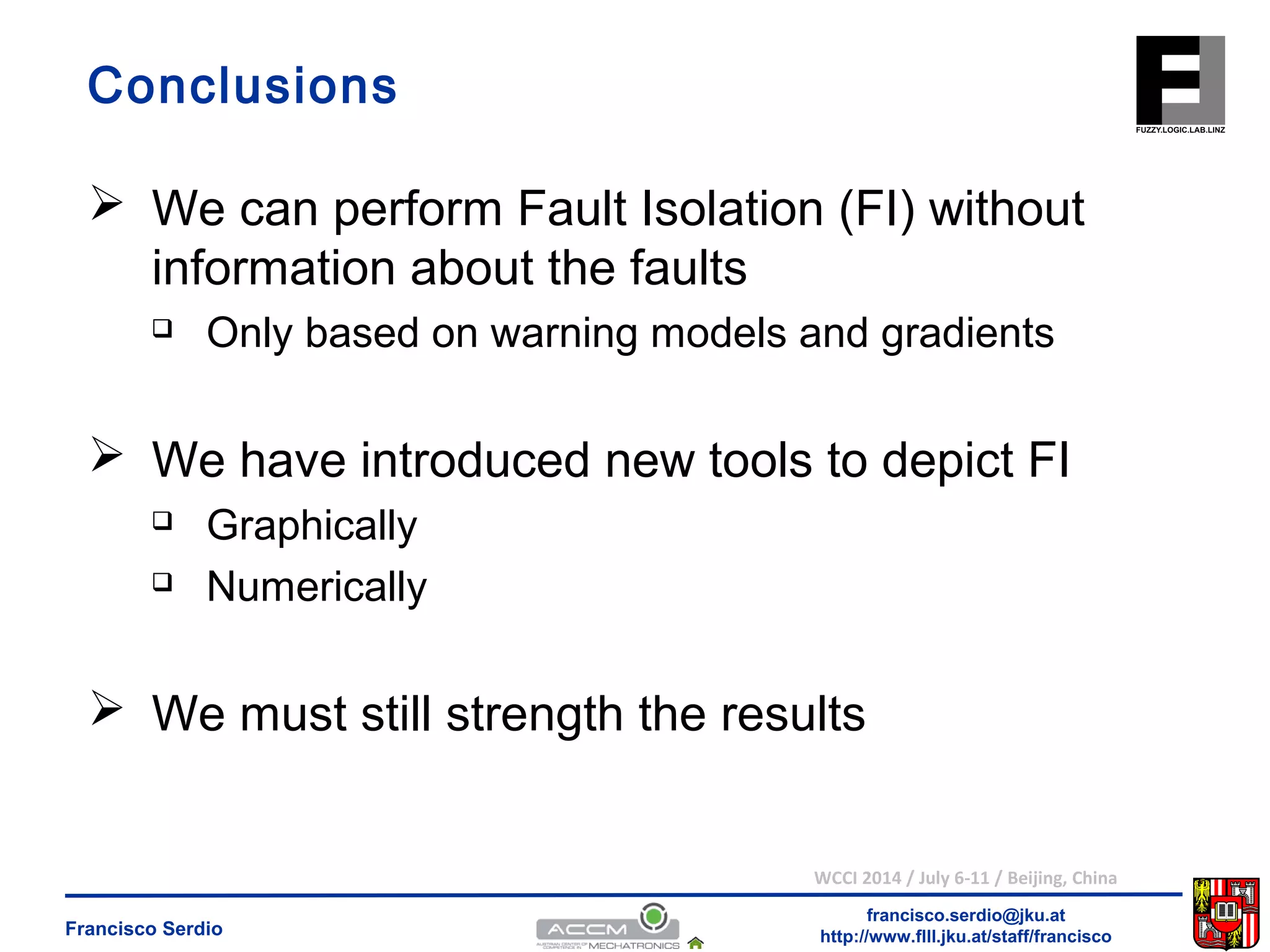The document discusses gradient-based fault isolation techniques. It begins by explaining the need for both fault detection and fault isolation in industrial processes. It then discusses commonly used residual-based approaches for fault detection and introduces the motivation for gradient-based fault isolation approaches. These approaches use partial derivatives of models to identify the process variables most responsible for detected faults. The document outlines some tools for visualizing fault isolation results and discusses opportunities to improve gradient aggregation methods and further narrow isolation performance gaps. It concludes that gradient-based techniques can perform fault isolation without prior fault information and more development is still needed to strengthen results.
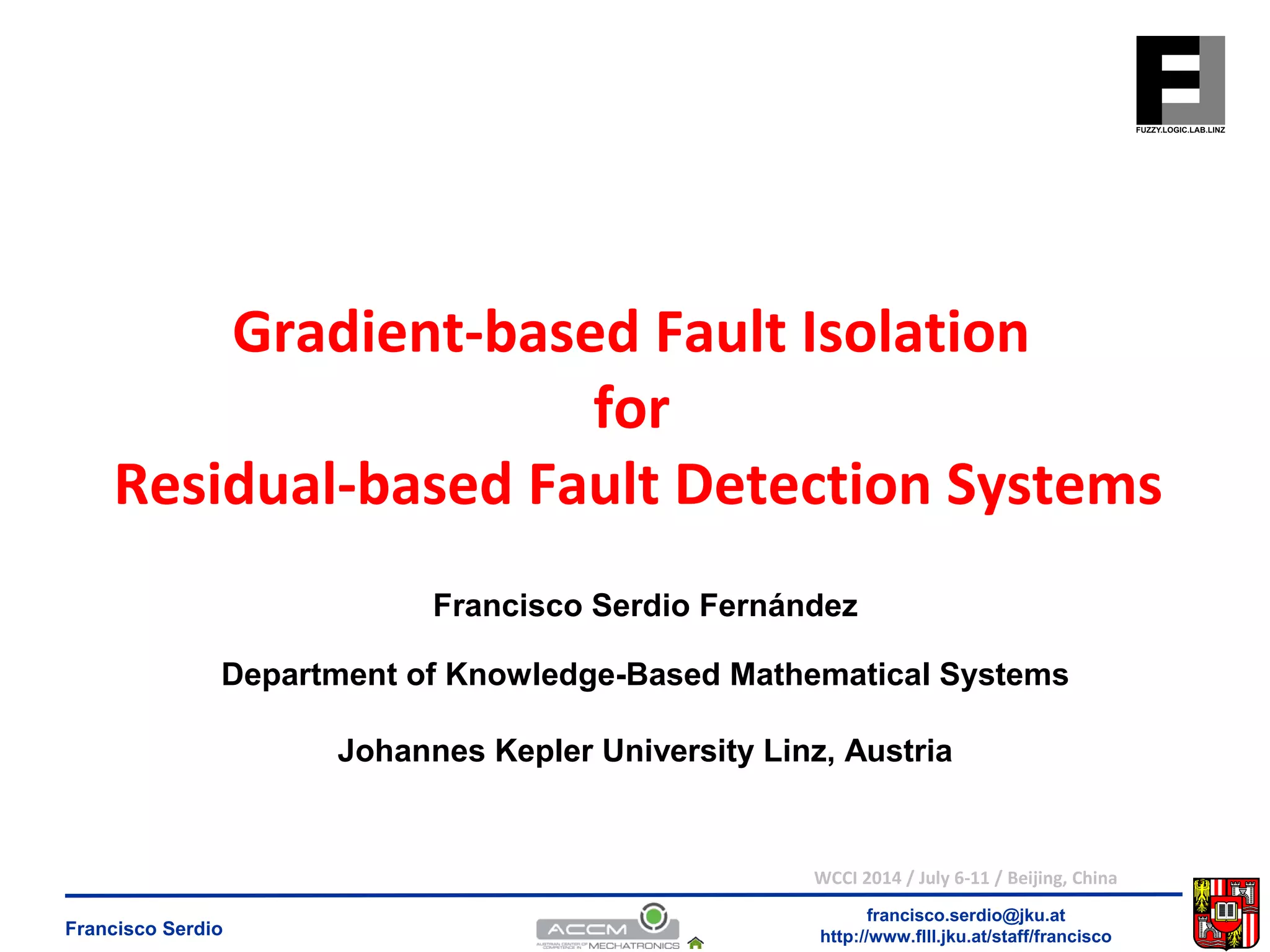
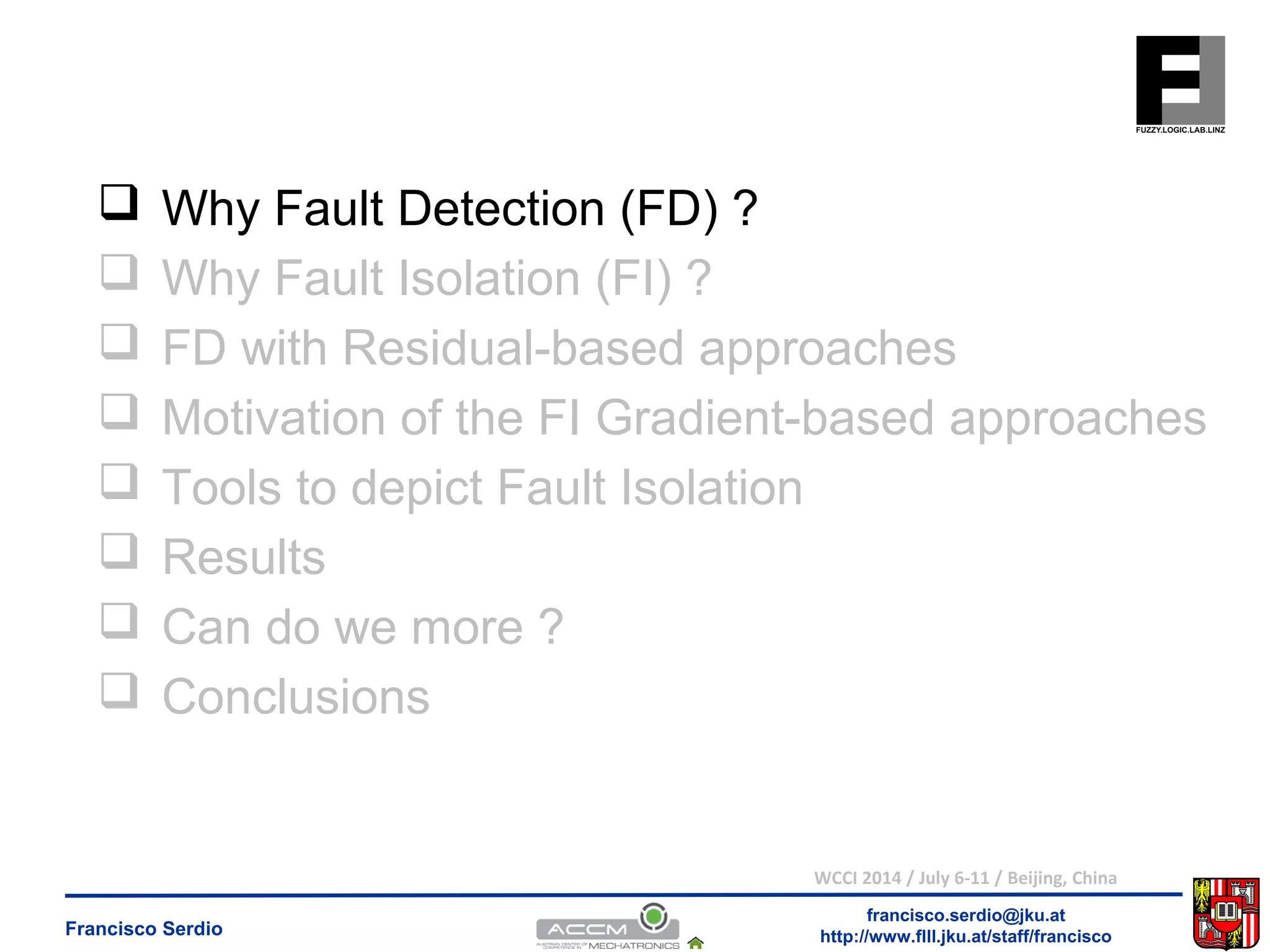
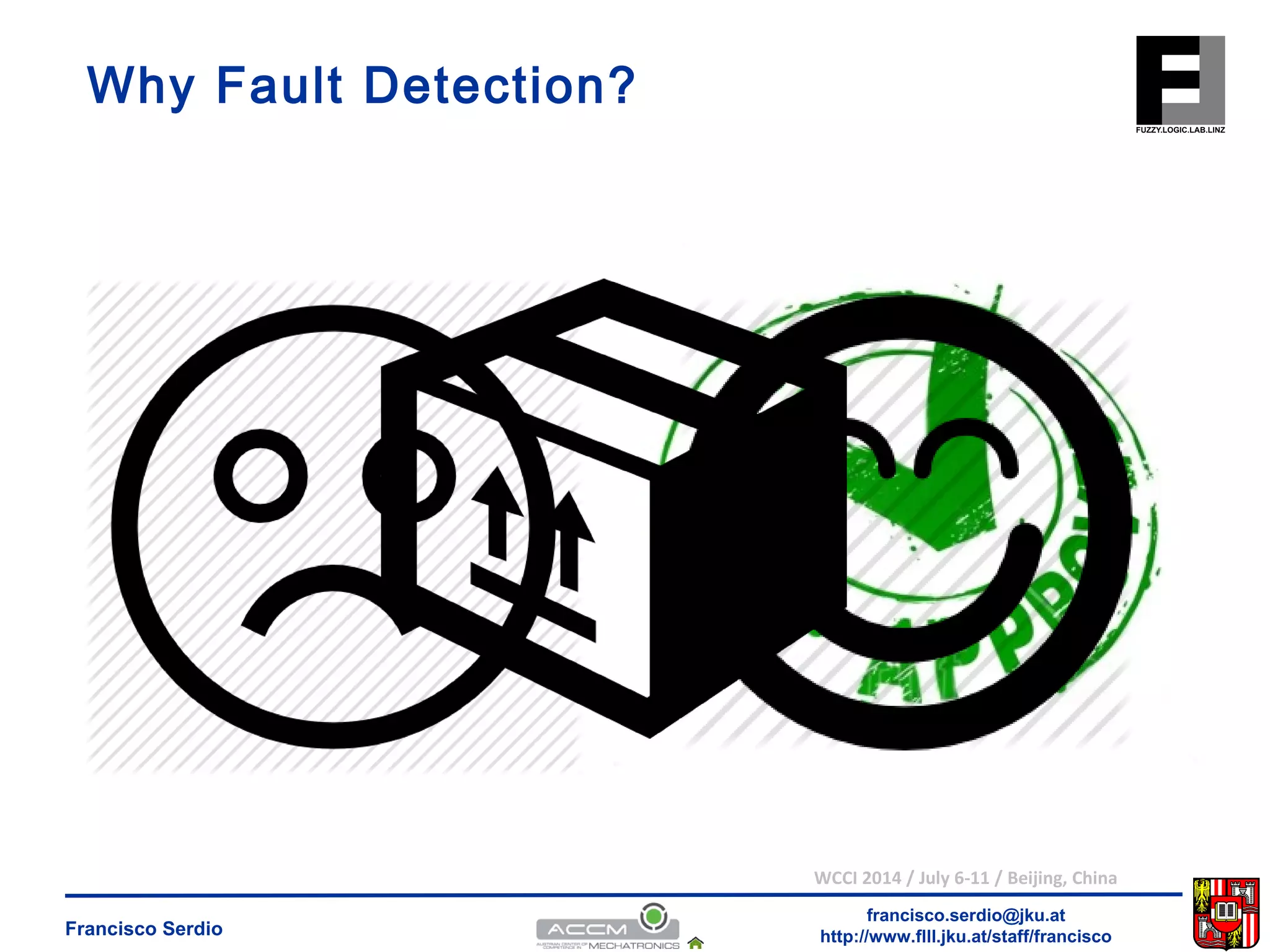
![Why Fault Detection?
Products with high quality demands
High quality is required also in the production chain
High quality is required also in the supply chain
[1] D. Blanchard. Supply Chain Management Best Practices. John Wiley & Sons,
Hoboken, NJ, USA, 2007.
Continuity in the production lines
Minimum down-time
[2] R. Iserman. Fault-Diagnosis Applications. Model-Based Condition Monitoring:
Actuators, Drives, Machinery, Plants, Sensors, and Fault-tolerant Systems. Springer,
Berlin Heidelberg, Germany, 2011.
WCCI 2014 / July 6-11 / Beijing, China
francisco.serdio@jku.at
High quality processes imply
http://www.flll.Francisco Serdio jku.at/staff/francisco](https://image.slidesharecdn.com/ieeewcci2014-141014080048-conversion-gate02/75/IEEE-WCCI-2014-4-2048.jpg)

![ Manual supervision is not affordable or in some
cases simply impossible
The precision of manual supervision usually depends
on the experience of the operators
and even on their performance on a given day
[3] E. Lughofer, J.E. Smith, P. Caleb-Solly, M. Tahir, C. Eitzinger, D. Sannen and M.
Nuttin. (2009). Human-machine interaction issues in quality control based on on-line
image classication. IEEE Transactions on Systems, Man and Cybernetics, part A:
Systems and Humans, 39(5), 960-971.
WCCI 2014 / July 6-11 / Beijing, China
francisco.serdio@jku.at
Why Fault Detection?
Manual process supervision
http://www.flll.Francisco Serdio jku.at/staff/francisco](https://image.slidesharecdn.com/ieeewcci2014-141014080048-conversion-gate02/75/IEEE-WCCI-2014-6-2048.jpg)
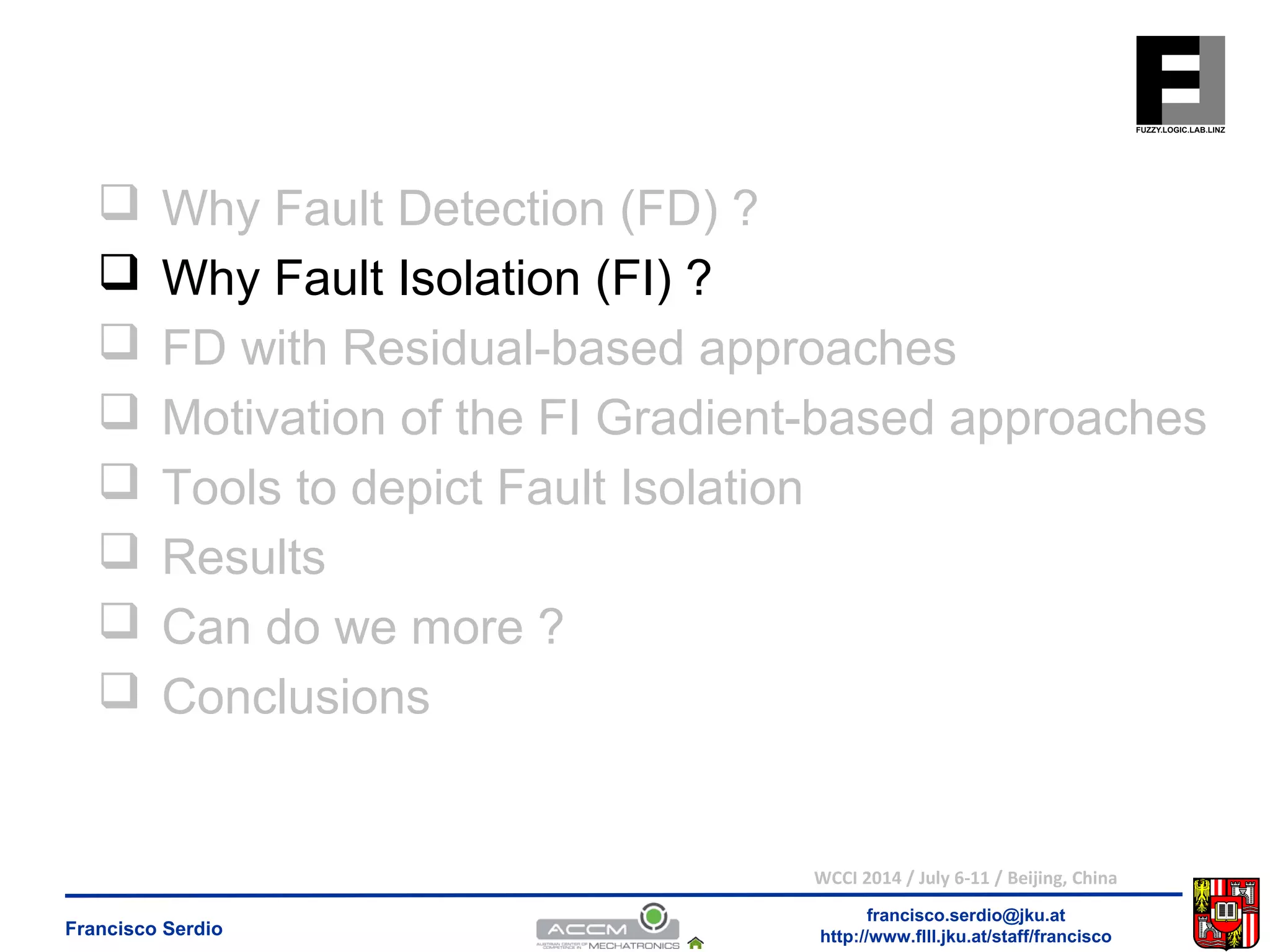
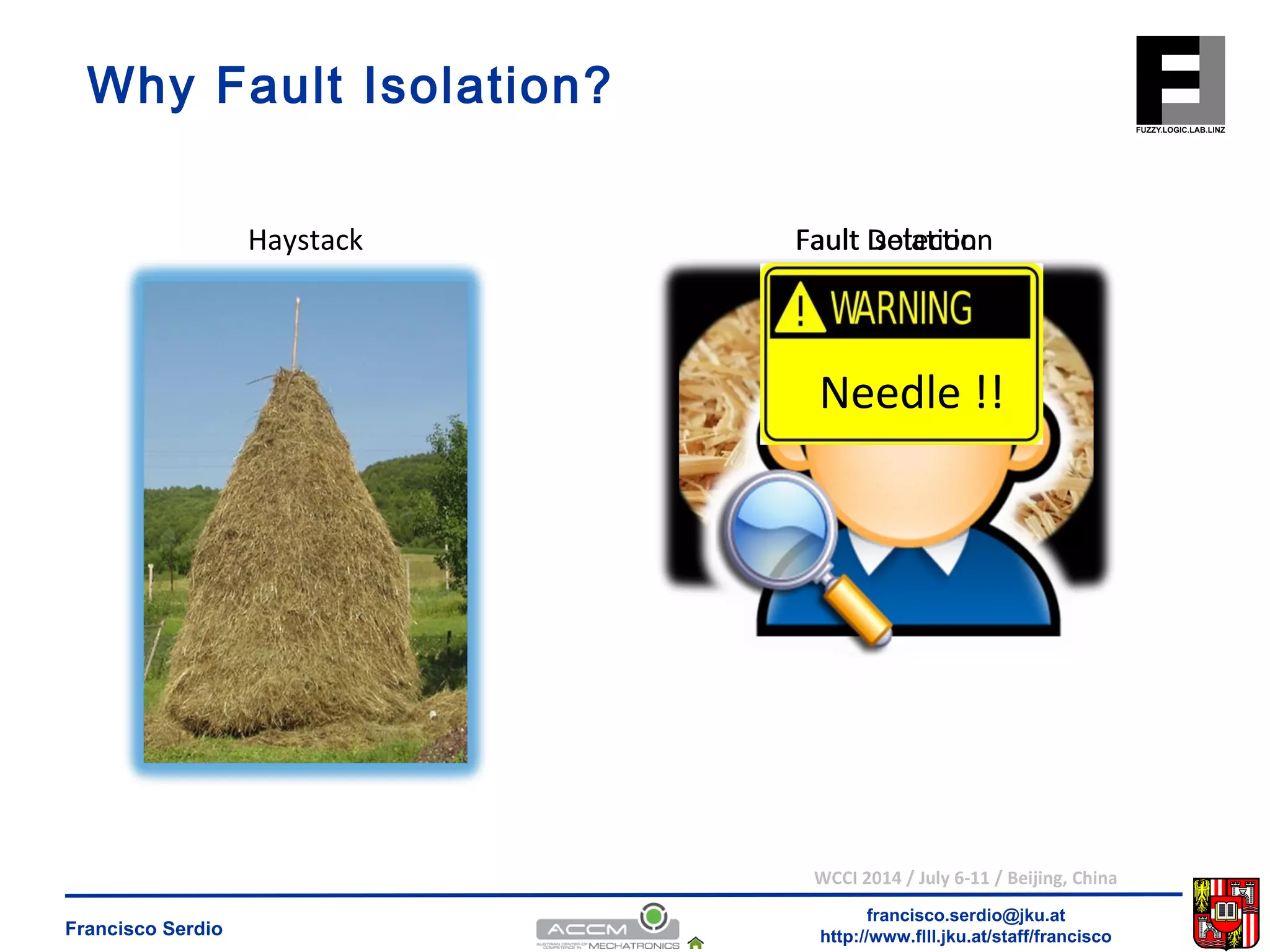
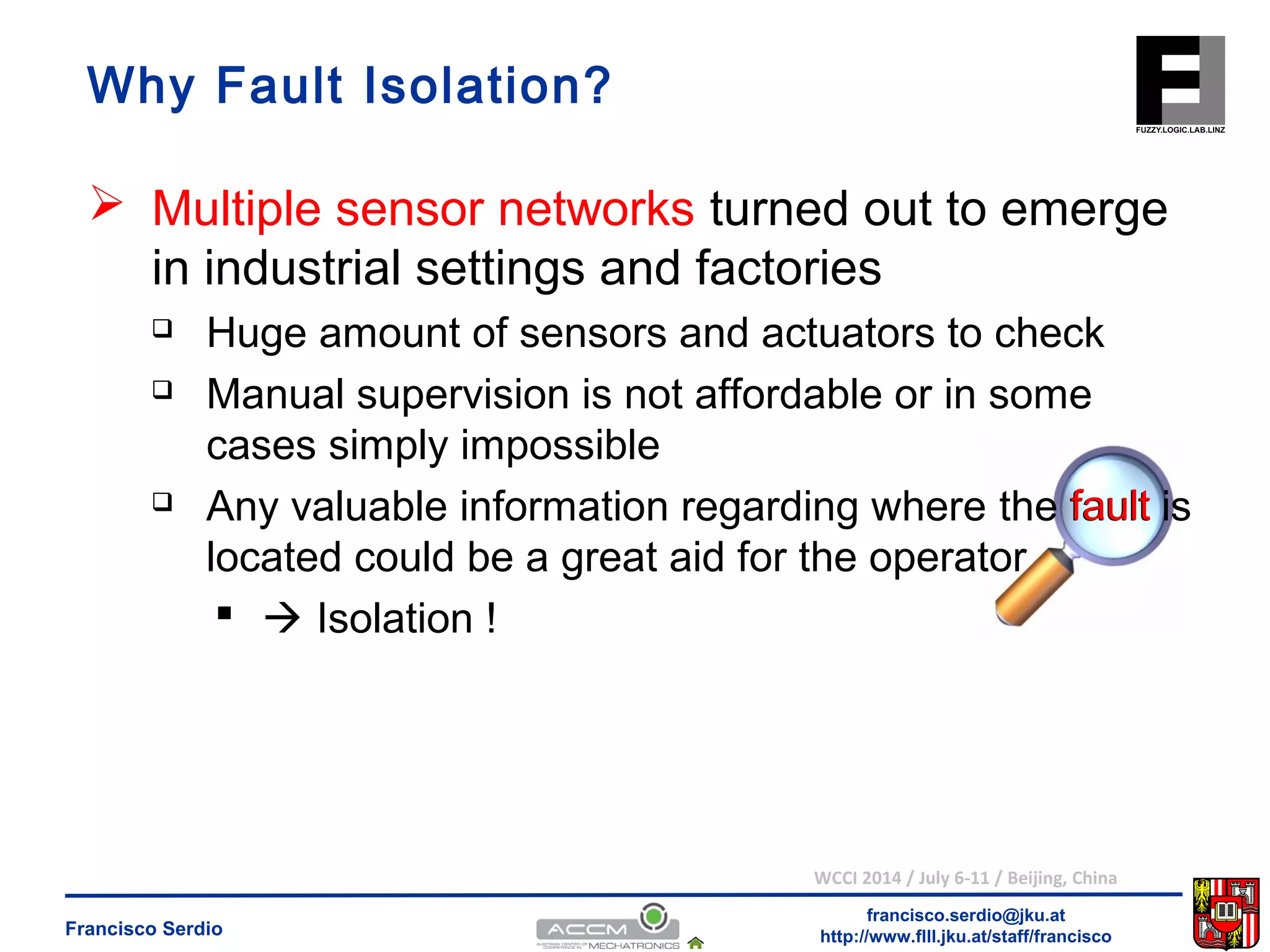
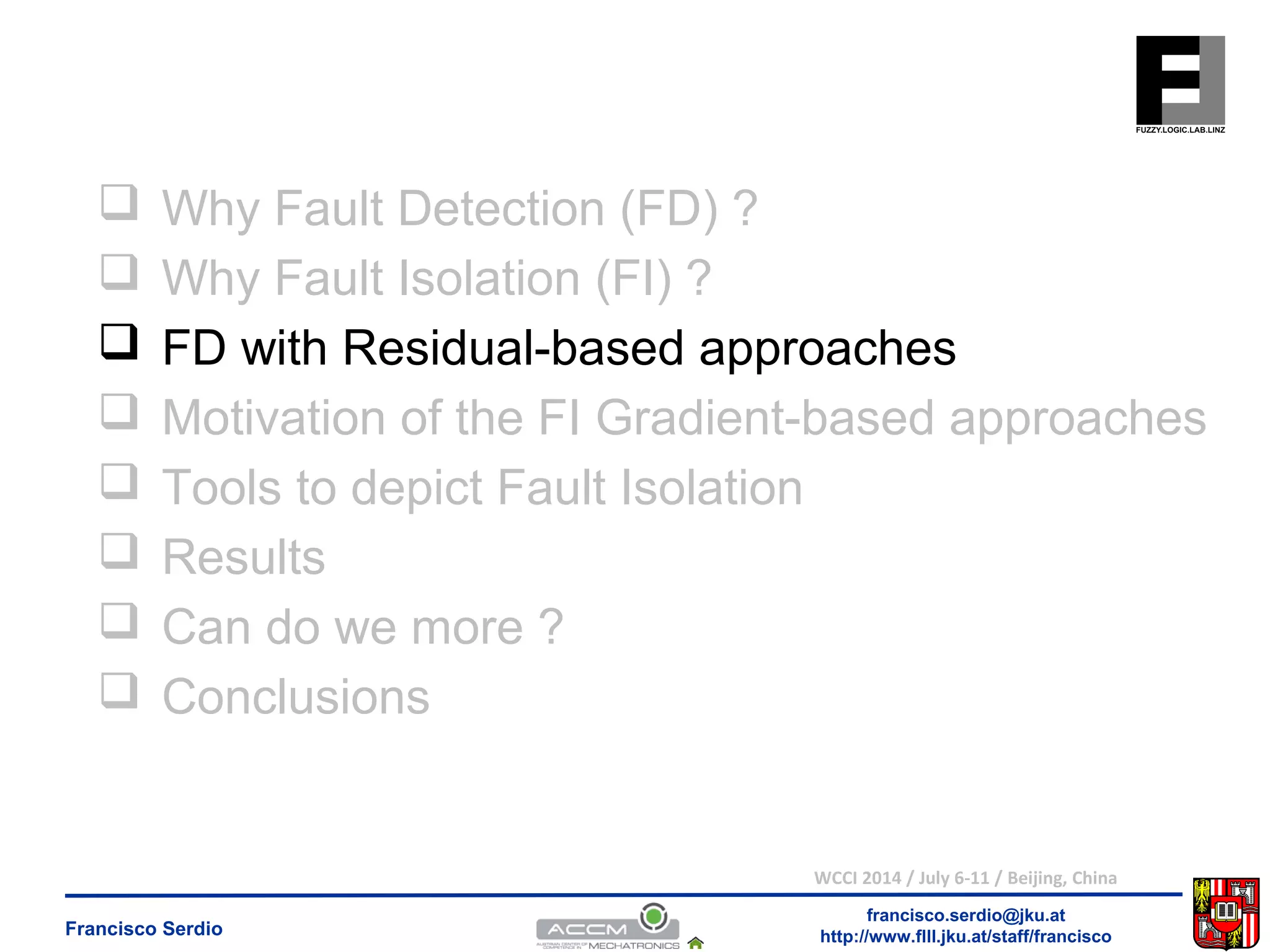
![FD with Residual-based approaches
Algebraic relationships among different sensors
Difference relationships among different sensor
outputs and actuator inputs
Inconsistencies, expressed as residuals, can be
used for detection and isolation purposes
[4] V. Venkatasubramanian, R. Rengaswamy, S. Kavuri and K. Yin. (2003). A review of
process fault detection and diagnosis: Part iii: Process history based methods.
Computers & Chemical Engineering, 27(3), 327-346.
WCCI 2014 / July 6-11 / Beijing, China
francisco.serdio@jku.at
Analytical Redundancy
Direct redundancy
Temporal redundancy
http://www.flll.Francisco Serdio jku.at/staff/francisco](https://image.slidesharecdn.com/ieeewcci2014-141014080048-conversion-gate02/75/IEEE-WCCI-2014-11-2048.jpg)
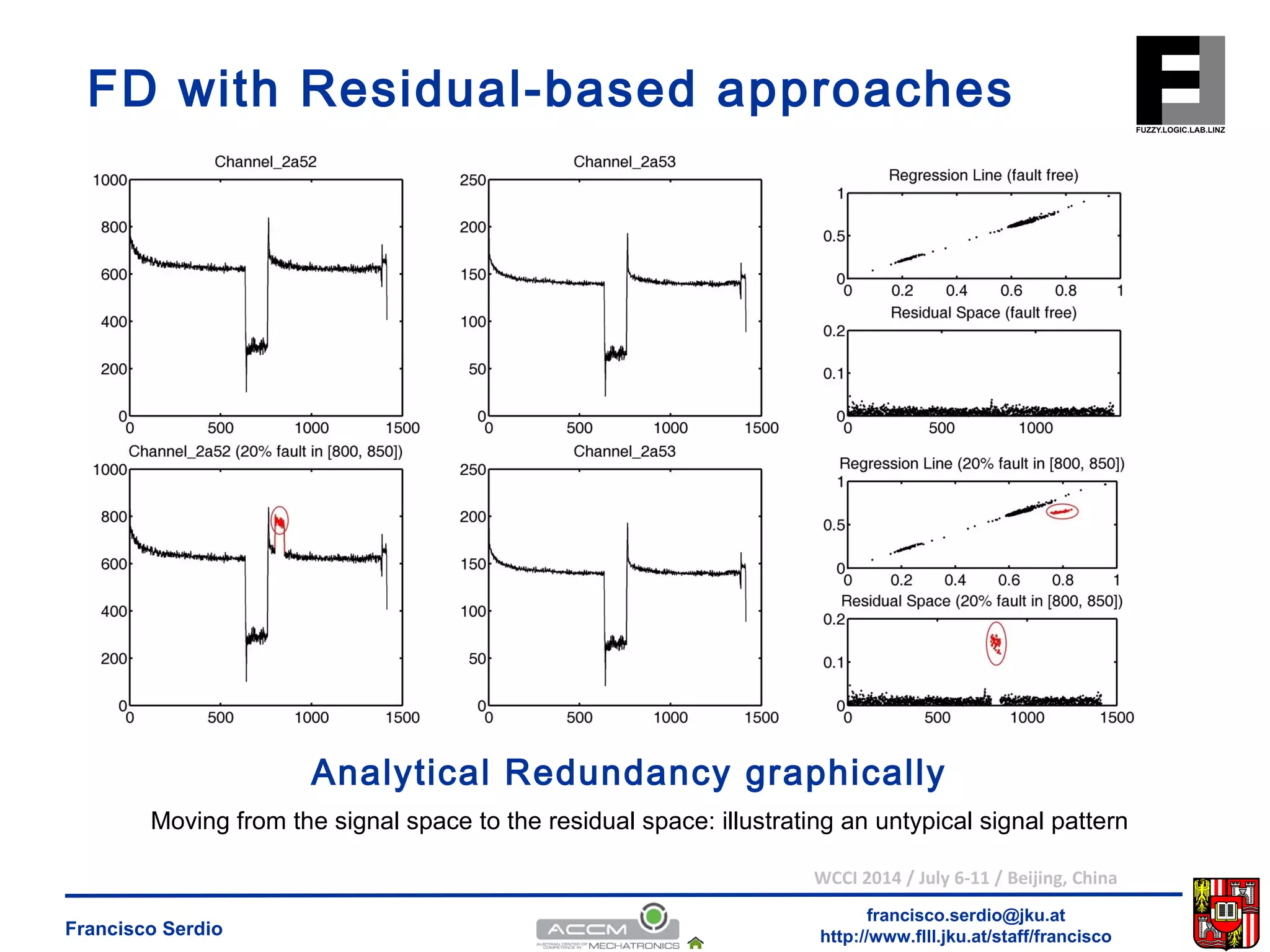
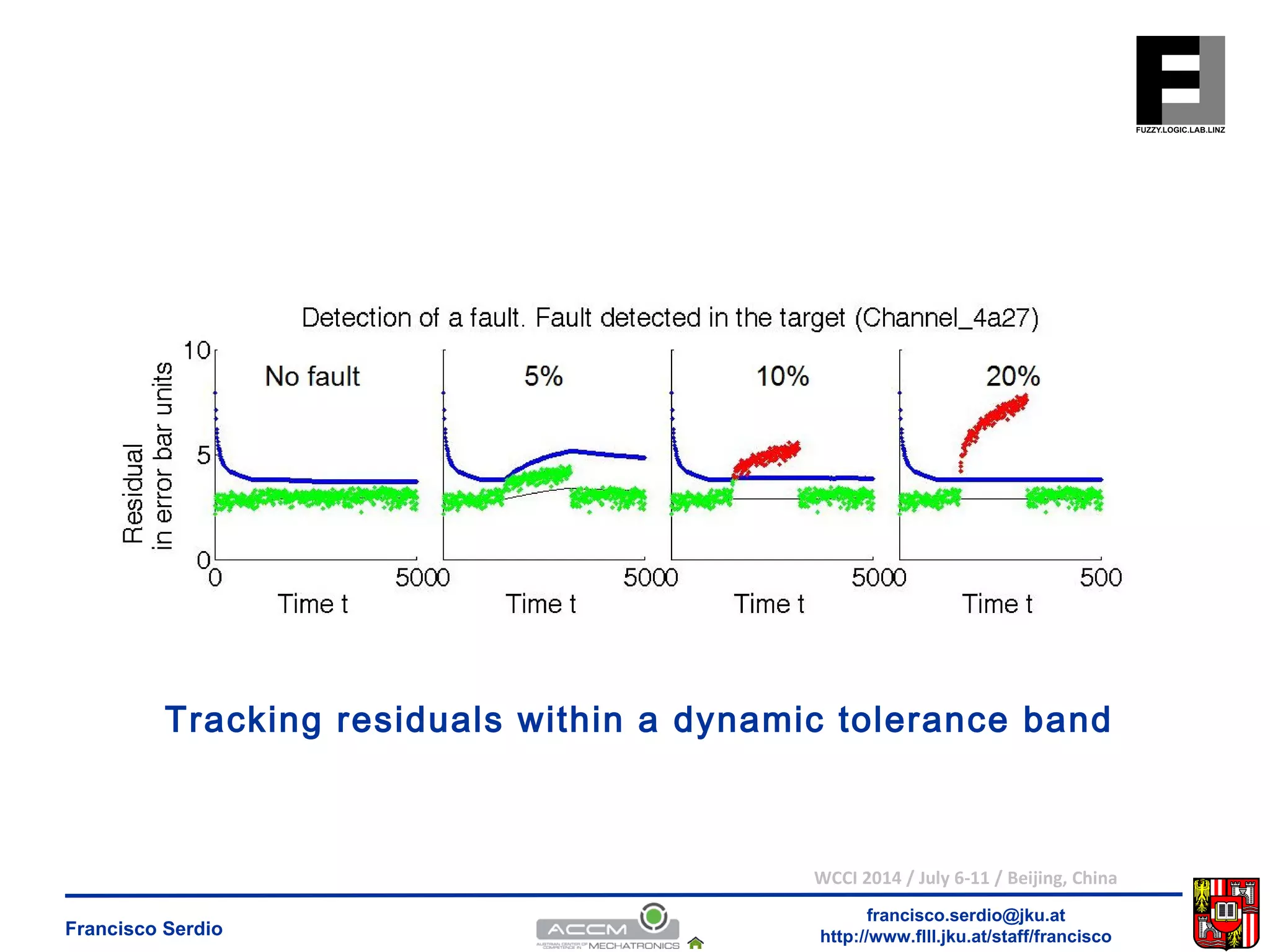
![Recall FD with Residual-based
approaches
More information regarding Fault Detection in
[5] F. Serdio, E. Lughofer, K. Pichler, T. Buchegger and H. Efendic, Data-Driven Residual-Based
Fault Detection for Condition Monitoring in Rolling Mills. Proceedings of the IFAC Conference on
Manufacturing Modeling, Management and Control, MIM '2013, St. Petersburg, Russia, 2013, pp.
1546-1551. (Winner of MIM 2013 Best paper award)
[6] F. Serdio, E. Lughofer, K. Pichler, T. Buchegger, and H. Efendic, Residual-based Fault Detection
using Soft Computing techniques for Condition Monitoring at Rolling Mills. Information Sciences,
vol. 259, pp. 304–330, 2014.
[7] F. Serdio, E. Lughofer, K. Pichler, T. Buchegger, M. Pichler and H. Efendic, Multivariate Fault
Detection using Vector Autoregressive Moving Average and Orthogonal Transformation in the
residual Space. Annual Conference of the Prognostics and Health Management Society, PHM 2013,
New Orleans, LA, USA, 2013, pp. 548-555.
[8] F. Serdio, E. Lughofer, K. Pichler, T. Buchegger, and H. Efendic, Fault Detection in Multisensor
Networks based on Multivariate Time-series Models and Orthogonal Transformations.
Information Fusion, vol. under revision (minor), 2014.
WCCI 2014 / July 6-11 / Beijing, China
francisco.serdio@jku.at
http://www.flll.Francisco Serdio jku.at/staff/francisco](https://image.slidesharecdn.com/ieeewcci2014-141014080048-conversion-gate02/75/IEEE-WCCI-2014-14-2048.jpg)
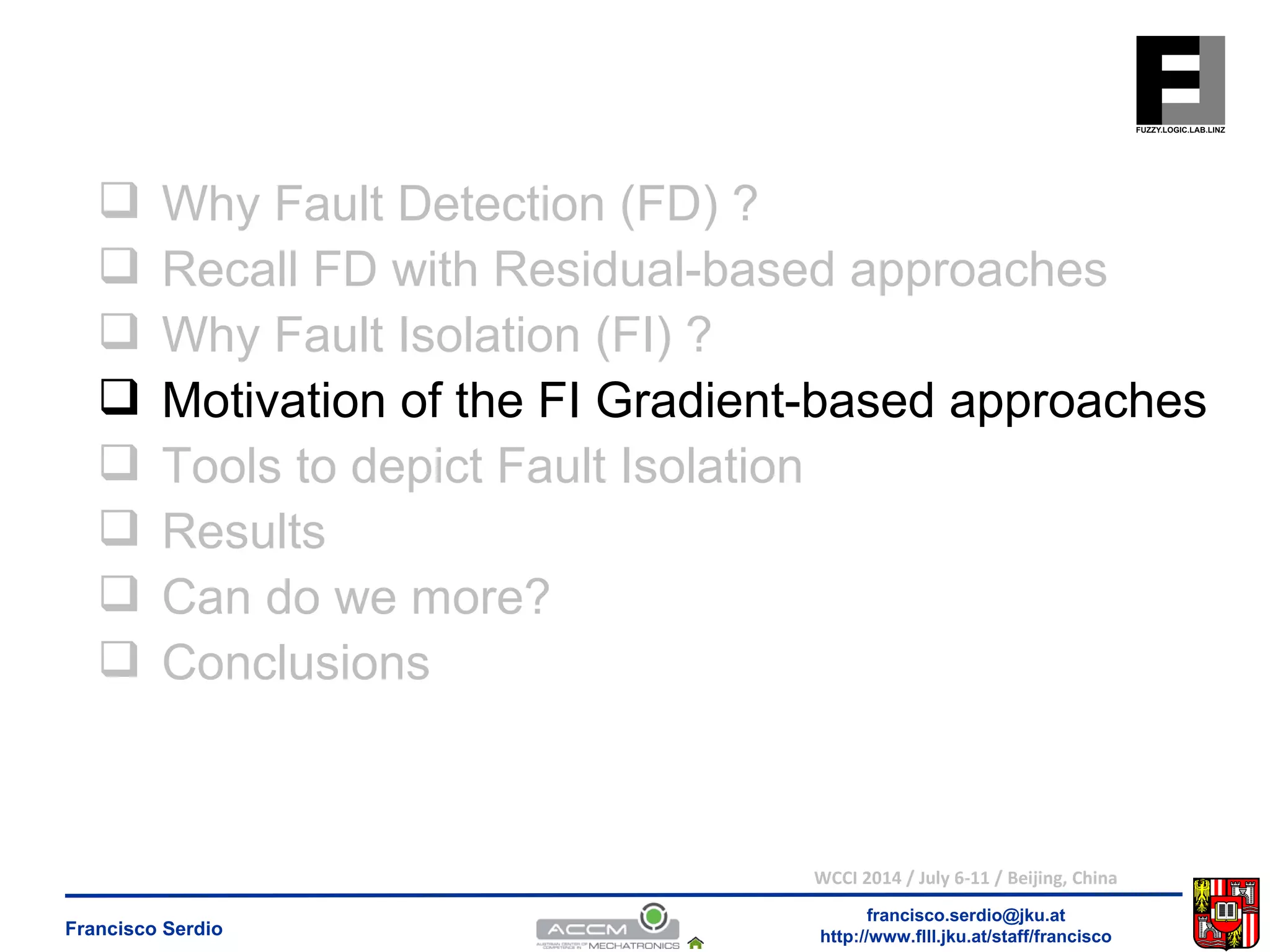
![Motivation of the FI Gradient-based
approaches
We are blind about faults
We do not know how a fault looks like
We do not have fault patterns (labeled data)
Process variable contribution plot
There is an extension to non-linear PCA
It reverts back to the original process variables
[9] P. Miller, R. Swanson, and C. Heckler, Contribution plots: A missing link in multivariate quality
control. Applied Mathematics and Computer Science, vol. 8, p. 775792, 1998.
[10] F. Jia, E. Martin, and A. Morris, Nonlinear principal components analysis with application to
process fault detection. International Journal of Systems Science, vol. 31, p. 14731487, 2001.
WCCI 2014 / July 6-11 / Beijing, China
francisco.serdio@jku.at
There is literature about PCA
http://www.flll.Francisco Serdio jku.at/staff/francisco](https://image.slidesharecdn.com/ieeewcci2014-141014080048-conversion-gate02/75/IEEE-WCCI-2014-16-2048.jpg)

